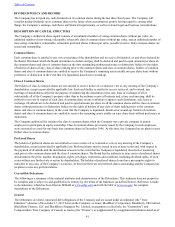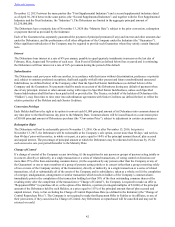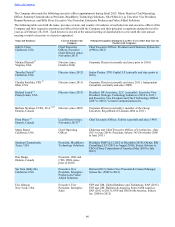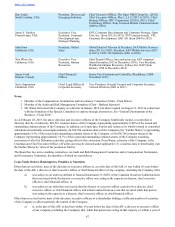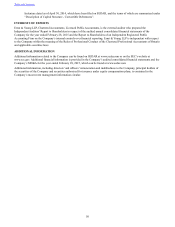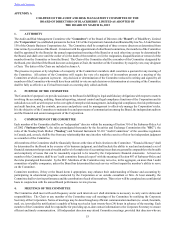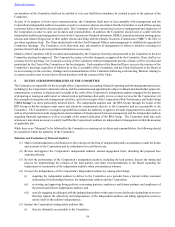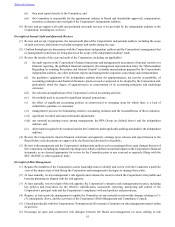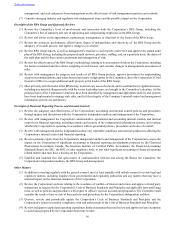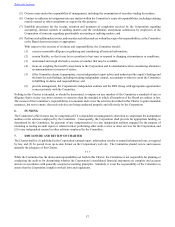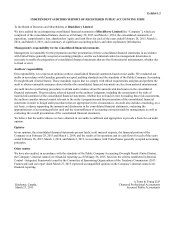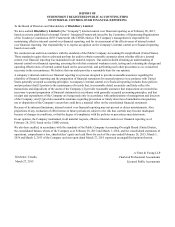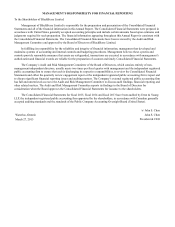Blackberry 2015 Annual Report Download - page 60
Download and view the complete annual report
Please find page 60 of the 2015 Blackberry annual report below. You can navigate through the pages in the report by either clicking on the pages listed below, or by using the keyword search tool below to find specific information within the annual report.
Table of Contents
51
GLOSSARY
Set forth below are certain terms used in this AIF:
3G wireless
Third generation (3G) wireless. Third generation wireless is a global framework that is implemented
regionally in Europe (UMTS), North America (CDMA2000) and Japan (NTT DoCoMo), among other
locations. 3G is designed for high-speed wireless multimedia data and voice. It offers high-quality audio
and video and advanced global roaming, which means users would be able to go anywhere and
automatically be handed off to whatever wireless system is available.
4G wireless
Fourth generation (4G) wireless. Fourth generation is a successor to 3G and 2G standards. The
nomenclature of the generations generally refers to a change in the fundamental nature of the service. The
4G refers to all IP packet-switched networks and increases in data speeds.
API Application Programming Interface. A set of routines, protocols and tools for building software apps.
ASIC Application Specific Integrated Circuit. An integrated circuit customized for a particular use.
CDMA
Code Division Multiple Access. A method for transmitting simultaneous signals over a shared portion of the
spectrum. The foremost application of CDMA is the digital cellular phone technology from QUALCOMM
that operates in the 800MHz band and 1.9GHz PCS band. Unlike GSM and TDMA, which divides the
spectrum into different time slots, CDMA uses a spread spectrum technique to assign a code to each
conversation.
Denial of
Service Attack
An attack designed to flood a network with unnecessary traffic in order to prevent legitimate users of a
system from having access.
EDGE See 3G Wireless.
EMS
Electronics Manufacturing Services. A term used for companies that design, test, manufacture, distribute,
and provide return/repair services for electronic components and assemblies for original equipment
manufacturers (OEMs).
Ev-Do Evolution-Data Optimized. A 3G wireless radio broadband data standard that enables faster speeds than are
available in existing CDMA networks or other 2G services, such as GPRS or EDGE.
Firewall
A technological barrier designed to prevent unauthorized or unwanted communications between sections of
a computer network.
Firmware
Computer programming instructions that are stored in a read-only memory unit, including flash, ROM,
PROM, EPROM and EEPROM, rather than being implemented through software.
GPRS
General Packet Radio Service. An enhancement to the GSM (see below) mobile communications system
that supports data packets. GPRS enables continuous flows of IP data packets over the system for such
applications as Web browsing and data access. GPRS differs from GSM’s short messaging service, which is
limited to messages of 160 bytes in length.
GPS Global Positioning System.
GSM
Global System for Mobile Communications. A digital cellular phone technology based on TDMA that is the
predominant system in Europe, but is also used around the world. Operating in the 900MHz and 1.8GHz
bands in Europe and the 1.9GHz PCS band in the U.S., GSM defines the entire cellular system, not just the
air interface (i.e. TDMA, CDMA). GSM phones use a Subscriber Identity Module (SIM) smart card that
contains user account information.
HSPA
High-Speed Packet Access. A family of radio interface standards that improves the speed and accuracy of
traffic over cellular networks. HSPA builds on the existing WCDMA technology to allow carriers to offer
better speeds and larger bandwidth intensive services like streaming audio and video.
iDEN
Integrated Digital Enhanced Network. A wireless communications technology from Motorola that provides
support for voice, data, short messages (SMS) and dispatch radio (two-way radio) in one phone. Operating
in the 800MHz and 1.5GHz bands and based on TDMA, iDEN uses Motorola’s VSELP (Vector Sum
Excited Linear Predictors) vocoder for voice compression and QAM modulation to deliver 64 Kbps over a
25 kHz channel. Each 25 kHz channel can be divided six times to transmit any mix of voice, data, dispatch
or text message.
IEC International Electrotechnical Commission
IEEE Institute of Electrical and Electronics Engineers


